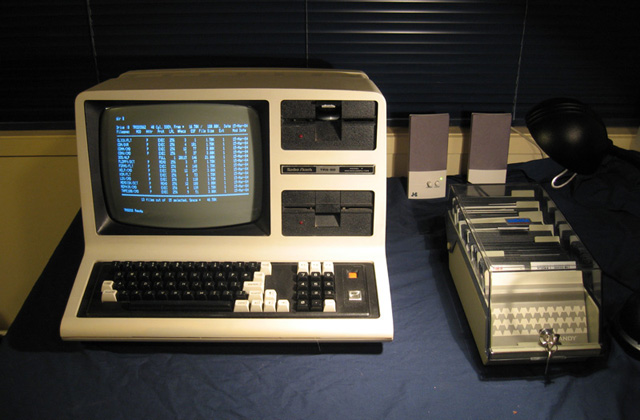| Tweet |
Making a TRS-80 Model III or 4 boot disk (and getting other TRS-80 software) from disk images
Introduction
If you have found this page directly from an Internet search (as opposed to a link from my disk imaging introduction page) you have most likely missed some important information. Please click to READ THIS INTRODUCTORY PAGE FIRST. It explains some generic aspects of disk imaging and why, even if you DO have a good bootable disk, it may not work.

Figure 1. My TRS-80 Model 4
Hardware requirements
To make disks like I did you'll need the following hardware:
- A PC with a 5.25 inch floppy disk drive (preferably a 360k double density one).
- An MS-DOS environment (not an MS-DOS prompt runiing in a Windows environment)
- Blank 5.25 inch double density disks in good condition
Software
The best way to image real disks for these machines is to use an emulator. The method involves mapping one of the emulator drives to the real floppy drive in the PC, then duplicating a disk image mapped to another emulated drive or copying the necessary files across to the real disk from those images.
There were two packages capable of this task. One from David Keil and the other from Matthew Reed. I've used both and find they do the job well.
David Keil's emulator (the one I used for most of my disk library) is abandonware and unsupported. The author's site is no longer present but the emulator can still be found at this archive.
Matthew's emulator is shareware and can be downloaded from here. You get the Model 4 component free, but to get the Model III/4 combo, a small one-time registration fee is needed.
Be sure to read the instructions well. I've found for imaging purposes both emulators behave best with a 360k drive as the target and when run in a strict MS-DOS environment. I do this on my Windows 98 box by configuring the machine to boot directly to MS-DOS. It works fine enabling me to copy standard 40-track, single-sided, double-density Model 4 and Model III disks including boot disks. Some (most!) copy protected disks may be difficult to duplicate due to their unique formats.
How about the Model 1?
This is much harder. The Model 1 boot disk is single density (or at least the first track is, even with double density disks!). However, some PC disk controllers are capable of writing single density. You can test yours using Dave Dunfield’s TESTFDC.COM under pure (no Windows) MS-DOS. If you have a disk controller capable of writing single-density, you are lucky. The Keil and Reed emulators will probably work. If not, there is no "software only " solution I know of.
One method involving hardware would be to use a real TRS-80 Model 1 connected to a PC with a serial "null modem" cable between them. You'll also need transfer software.
Another option is to buy an HxC floppy disk emulator. You could then ditch the floppy drives altogether, or at least copy files to disks using a real drive attached to the Model 1 alongside the HxC.
I made my own Model 1 disks from disk images by a special piece of hardware called a Semi-virtual diskette (SVD), which was connected between the serial port of a PC and the disk controller of a real Model 1 or Model 1 clone. These SVDs are not common though.
Last words
Imaging from these emulators worked for me but results may vary. It depends on your PC disk controller. Some of them simply struggle to make TRS-80 Model 1/III/4 disks as explained by Matthew Reed here (see the section on "Virtual disks and TRS-80 disks"). Tim Mann also has generic but detailed instructions on some of the procedures, pitfalls and problems of writing TRS-80 disks from images here.
If you are lucky, you'll have the necessary hardware and this method will work well. Disk images can be found on the web in various places. Also, if your system is already up and running and you're just after files (as opposed to disk images), serial transfer is also an option.
Good luck!
Tez
Original article 27th December, 2011. Updated 28th July, 2015. Updated again 22nd May, 2017
| Tweet |